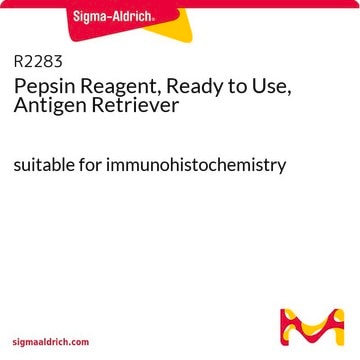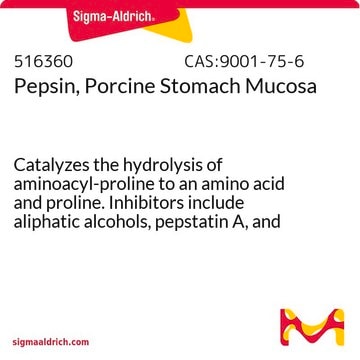10108057001
Roche
Pepsin
lyophilized (salt-free), ~2500 units/mg protein (At 37 °C with hemoglobin as the substrate. One unit is the enzyme activity which liberates the amount of Tyr producing an increase in the absorbance of 0.001/minute at 280 nm.)
Synonym(s):
pepsin
Sign Into View Organizational & Contract Pricing
All Photos(1)
About This Item
Recommended Products
biological source
pig gastric mucosa
Quality Level
form
lyophilized (salt-free)
specific activity
~2500 units/mg protein
packaging
pkg of 1 g
manufacturer/tradename
Roche
optimum pH
1.8-2.2
shipped in
wet ice
storage temp.
2-8°C
General description
Pepsin is an aspartic endoproteinase isolated from pig gastric mucosa. It is mainly used for the unspecific hydrolysis of proteins and peptides in acidic media. It also provides a limited hydrolysis of native immunoglobulins to yield biologically active fragments.
Specificity
Aspartic endopeptidase with relatively broad specificity. Preferential cleavage: hydrophobic, preferably aromatic, residues in P1 and P1′ positions.
Application
Pepsin has been used for the digestion of liver tissue obtained from rat.
Preparation Note
Working concentration: 0.05 to 0.5 mg/ml
Storage conditions (working solution): A pepsin solution is stable at 2 to 8 °C, at least for one week, at neutral pH and under germfree conditions. Frozen aliquots of the enzyme solution are expected to be more stable.
A stock solution in 10 mM HCl (5-10 mg/ml) should be stable for at least one week at 2 to 8 °C, too. Storage light protected, tightly closed.
A short (2 minutes) incubation at 40 °C has negligible effect on the activity of lyophilized pepsin or pepsin in solution.
Storage conditions (working solution): A pepsin solution is stable at 2 to 8 °C, at least for one week, at neutral pH and under germfree conditions. Frozen aliquots of the enzyme solution are expected to be more stable.
A stock solution in 10 mM HCl (5-10 mg/ml) should be stable for at least one week at 2 to 8 °C, too. Storage light protected, tightly closed.
A short (2 minutes) incubation at 40 °C has negligible effect on the activity of lyophilized pepsin or pepsin in solution.
Analysis Note
At 37 °C with hemoglobin as the substrate. One unit is the enzyme activity which liberates the amount of Tyr producing an increase in the absorbance of 0.001/minute at 280 nm.
Other Notes
For life science research only. Not for use in diagnostic procedures.
Signal Word
Danger
Hazard Statements
Precautionary Statements
Hazard Classifications
Eye Irrit. 2 - Resp. Sens. 1 - Skin Irrit. 2 - STOT SE 3
Target Organs
Respiratory system
Storage Class Code
11 - Combustible Solids
WGK
WGK 1
Flash Point(F)
Not applicable
Flash Point(C)
Not applicable
Certificates of Analysis (COA)
Search for Certificates of Analysis (COA) by entering the products Lot/Batch Number. Lot and Batch Numbers can be found on a product’s label following the words ‘Lot’ or ‘Batch’.
Already Own This Product?
Find documentation for the products that you have recently purchased in the Document Library.
Customers Also Viewed
Lauren M Ashwood et al.
BMC biology, 21(1), 121-121 (2023-05-25)
The ShK toxin from Stichodactyla helianthus has established the therapeutic potential of sea anemone venom peptides, but many lineage-specific toxin families in Actiniarians remain uncharacterised. One such peptide family, sea anemone 8 (SA8), is present in all five sea anemone superfamilies.
Marie van Dijk et al.
Prenatal diagnosis, 42(13), 1612-1621 (2022-11-08)
Noninvasive Prenatal Diagnosis has recently been introduced for a limited number of monogenetic disorders. However, the majority of DNA diagnostics still require fetal material obtained using an invasive test. Recently, a novel technique, TRIC (Trophoblast Retrieval and Isolation from the
Ganesan Arunkumar et al.
Science advances, 8(9), eabl5621-eabl5621 (2022-03-03)
Chromosome instability is a critical event in cancer progression. Histone H3 variant CENP-A plays a fundamental role in defining centromere identity, structure, and function but is innately overexpressed in several types of solid cancers. In the cancer background, excess CENP-A
William D Kim et al.
Frontiers in genetics, 13, 1045738-1045738 (2022-11-29)
Mutations in CLN5 cause a subtype of neuronal ceroid lipofuscinosis (NCL) called CLN5 disease. The NCLs, commonly referred to as Batten disease, are a family of neurodegenerative lysosomal storage diseases that affect all ages and ethnicities globally. Previous research showed
Claus Kordes et al.
The Journal of clinical investigation, 124(12), 5503-5515 (2014-11-18)
Retinoid-storing hepatic stellate cells (HSCs) have recently been described as a liver-resident mesenchymal stem cell (MSC) population; however, it is not clear whether these cells contribute to liver regeneration or serve as a progenitor cell population with hepatobiliary characteristics. Here
Our team of scientists has experience in all areas of research including Life Science, Material Science, Chemical Synthesis, Chromatography, Analytical and many others.
Contact Technical Service










